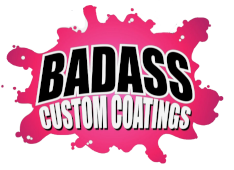PLASTIC IDENTIFICATION
This table shows the plastic most often used in automotive applications. Don’t see the symbol on this table? The plastics with the yellow background are thermoset plastics.
| Symbol & Type | How to identify | Typical Usage |
| DCPD, PDCPD, Metton (Polydicyclopentadiene) | Rigid Material, no fibers, dark gray in color. | Large truck and tractor panels and hoods |
| PUR, RIM, RRIM Thermoset polyurethane | Usually flexible, maybe yellow or gray, bubbles and smokes when attempting to melt. | Flexible bumper covers (especially on domestics), filler panels, rocker panel covers, snowmobile cowls. |
| SMC, UP, FRP, Fiberglass | Rigid, polyester matrix reinforced with glass fibers, sands finely | Rigid body panels, fenders, hoods, deck lids, header panels, spoilers |
| XPE, XLPE, PE-Xb, PEX, Crosslinked Polyethylene | Semi-Flexible, waxy or greasy feel, softens when heated but does not melt | Gas tanks, kayaks, canoes, trash cans, use is declining |
| ABS (Acrylonitrile Butadiene Styrene) | Rigid, often white but may be molded in any color, sands finely. Very pungent odor when heated. | Instrument panels, grilles, trim moldings, consoles, armrest supports, street bike fairings. |
| HDPE Polyethylene | Semi-flexible, melts & smears when grinding, usually semi-translucent, waxy or greasy feel. | Overflow tanks, inner fender panels, water storage tanks, gas tanks, kayaks, canoes, playground equipment. |
| PA, PA-6, PA Polyamide (Nylon) | Semirigid or rigid, sands finely | Radiator tanks, headlamp bezels, exterior trim finish parts, mirrors, plastic engine parts |
| PBT Polybutylene terphthalate | Semi-rigid or rigid, sands finely. | Automotive panels, electrical connectors, under-hood parts. |
| PC + ABS Pulse (Polycarbonate & ABS) | Rigid, sands finely, usually dark in color | Door skins (Saturn), instrument panels, street bike fairings |
| PC + PBT, Xenoy (Polycarbonate blend), SLX | Rigid, sands finely, usually dark in color | Bumper covers (primarily Ford products, 84-95 Taurus, Aerostar, some Mercedes and Hyundai’s) |
| PE / LDPE Polyethylene | Semi-flexible, melts & smears when grinding, usually semi-translucent, waxy or greasy feel. Smells like a candle when melting. | Overflow tanks, inner fender panels, water storage tanks, gas tanks, kayaks, canoes, playground equipment, trash cans. |
| PETE, PET Polyethylene Terephthalate | Flexible, strong | Soda bottles, various yarn fibers, headliners, fuse boxes, door panels |
| PP Polypropylene | Semi-flexible, melts & smears when grinding, waxy or greasy feel, usually a bit stiffer than PE’s | Bumper covers (usually blended with EPDM), inner fenders, radiator shrouds, gas tanks, battery cases, interior panels |
| PPE, PPE+PS Polyphenylene Ether | Semi-rigid, sands finely, usually off-white or black in color | Fenders, exterior trim, rear hatch panels |
| PPO + PA Noryl GTX (Nylon blend) | Semi-rigid, sands finely, usually off-white in color. | Fenders (Saturn & GM), exterior trim |
| PVC Polyvinyl Chloride | Rigid, sands finely, usually white or gray but can be made any color | Pipe, siding, window frames, decking, gutters, speed bumps |
| TPE Thermoplastic Elastomer | Semi-flexible, usually black or gray, melts & smears when grinding. | Bumper covers, filler panels, under hood parts. |
| TPO, EPM, TEO Thermoplastic Olefin | Semiflexible, usually black or gray in color, melts & smears when grinding | Bumper covers, air dams, grilles, interior parts, instrument panels, snowmobile cowls. |
| TPU, TPUR – Thermoplastic Polyurethane | Flexible, sands finely | Bumper covers, soft filler panels, gravel deflectors, rocker panel covers |
PETE
HDPE – high density polyethylene
PVC – polyvinyl chloride
LDPE – low density polyethylene
PP – polypropylene
PS – polystyrene
Resins not mentioned above, or a combination of plastics.
PLASTIC IDENTIFICATION – FLOAT TEST BURN TEST
S(SINK) F(FLOAT) & Y(BURN) N(NO BURN)
TPU – Thermoplastic Urethane S/N
PP – Polypropylene F/Y
ABS – Acrylonitile Butadiene Styrene S/Y
LDPE – Low Density Polyethylene F/Y
TPO – Thermoplastic Olefin F/Y
PA – Polyamide (Nylon) S/Y
PC – Polycarbonate S/N
PPE+PS – Polyphenylene Ether+Polystyrene S/N
PVC – Polyvinyl Chloride S/N
PBT – Polybutylene Terephthalate S/N
HDPE – High Density Polyethylene S/Y
PET – Polyethylene Terephthalate S/N
ASA – Acrylotirile Styrene Acrylate S/Y
PA+PPE – Polyamide + Polyphenylene Ether S/Y
POM – Polyoxymethylene S/Y
Acrylic/PVC – Kydex® S/Y
PP+GF15 – Polypropylen+15% Glass Fibers F/Y
HDPE+GF15 – High Density Polyethylene + 15% Glass Fibers F/Y
PC+ABS – Polycarbonate + Acrylonitrile Butadiene Styrene S/N
PA+GF15 – Polyamide (Nylon) + 15% S/Y Glass Fibers

